Monero Mining: The Ultimate Guide on How to Mine Monero (XMR)
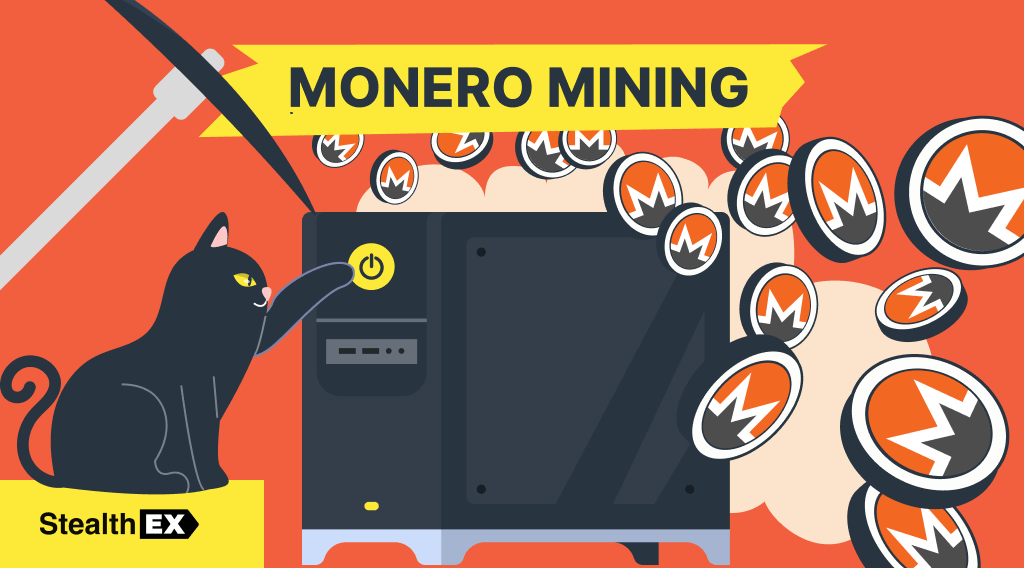
Monero (XMR) was among the first crypto assets with cryptography that offered real advances in privacy and fungibility over available alternatives. The majority of well-known cryptocurrencies, like Ethereum (ETH) and Bitcoin (BTC), function on an open, unchangeable ledger that makes transactions visible to all parties. Although Monero is also an open-source blockchain, its features are intended to preserve user anonymity and lessen traceability. One of the ways to support this privacy coin is to mine it. Monero mining ensures the safety of the network, and it is an important process for the Monero ecosystem. In this article, we’ll try and find out how to mine XMR and if it is profitable.
Article contents
Understanding Monero Mining
Verifying transactions on the Monero network and appending them to the blockchain is known as Monero mining. Monero mining is validating and adding new transactions to the Monero blockchain while securing the network against potential attacks. Miners earn freshly minted Monero currency by applying their computing power to solve challenging mathematical puzzles.

This process is known as Proof-of-Work (PoW) mining called CryptoNight, which is essential for maintaining the security and integrity of the Monero network. This algorithm ensures that the mining process is accessible to a wider range of participants and prevents the concentration of mining power in the hands of a few. In contrast to Bitcoin, which mines using the SHA-256 method, Monero employs a special algorithm known as RandomX, an ASIC-resistant algorithm developed by Monero contributors, which aims to remain mineable by common consumer-grade hardware.
There are various reasons why Monero mining is so popular. Primarily, Monero’s emphasis on privacy has drawn people who respect secrecy and anonymity in their financial dealings. Monero offers customers a great degree of anonymity by using sophisticated cryptographic algorithms to guarantee that the sender, recipient, and transaction value stay hidden on the blockchain.
In addition, Monero’s dedication to community-driven development and decentralization has won over cryptocurrency fans all around the world. The Monero community actively participates in the protocol’s development, helping to keep it strong, safe, and flexible enough to meet new obstacles as they arise. This cooperative strategy has increased confidence and trust in Monero, which has increased its appeal.
CryptoNight Algorithm Lies at the Center of Monero Mining
CryptoNight is a PoW mining algorithm for CPU and GPU mining, designed to be ASIC-resistant to prevent the centralization of mining power. It hopes to help users mine more efficiently using a combination of hashing functions, including the CryptoNight and the Keccak hash functions.
Its cryptographic hash function works around the Advanced Encryption Standard (AES), a military-level algorithm for extreme security, making CryptoNight a mining algorithm highly focused on security. Since Monero started using it as the hash algorithm for its blockchain consensus, CryptoNight’s reputation as a security algorithm has strengthened across the crypto world. The CryptoNight algorithm’s creation is fascinating and recalls the origin of Bitcoin. Its creator, Nicolas van Saberhagen, disappeared, just like the famous Satoshi Nakamoto.
Mining Requirements
Here is the basics of what you need to start mining Monero:
- A computer with a reliable internet connection.
- Monero mining hardware.
- Monero mining software.
- A Monero mining pool (if you’re not mining individually).
- A Monero wallet.
Given that Monero mining is intended to be inefficient for GPUs and difficult for ASICs, you should be able to operate your own XMR mining business without having to spend a fortune. You will still need to spend money on a strong computer with a capable CPU and adequate RAM (often 2 GB set aside for mining) in order to turn a profit. The AMD EPYC 7502P 32-Core 2.5 GHz processor is arguably the best processor available for XMR mining. With 32 cores, the massive CPU may reach up to 23.9 Kh/s when using Linux OS’s RandomX Monero algorithm.
There are several options when it comes to mining software. As already said, to solo mine, the CLI or GUI wallets can be used (CPU only). If you want to mine to a pool or mine with a GPU, you’ll need dedicated software. Miners can choose between XMRig or CSminer.
Before opting to mine XMR, it’s important to consider your electricity bills. It may turn out to be unprofitable to mine Monero on your own. A stable internet connection is also crucial to the whole process. Efficiency is another crucial factor in selecting the right Monero mining software. Efficient software minimizes resource consumption, reducing energy costs and maximizing your profitability. By choosing software that efficiently utilizes your hardware’s processing power, you can mine Monero more effectively while minimizing your environmental footprint.
Setting up a Monero Wallet
To be able to receive your mining rewards, you will need to set up a Monero wallet. It can be one of the most popular options, such as Exodus or Monero GUI Wallet or even a web-browser version of the famous MetaMask. There’s always the official Monero wallet called MyMonero. Many consider it to be the best, and it’s hard to disagree, but an excellent lightweight alternative is available to XMR users. MyMonero is a handy open-source Monero wallet (designed to store the Monero cryptocurrency) you can download on Windows, macOS, Linux, Android, and iOS.
Whenever using any wallet, always make sure that your private keys are entirely in your possession. And make sure to choose the best Monero wallet provided by a company with a long track record of security that uses features such as two-factor authentication.
Mining Pool vs Solo Mining
| Solo | Pool |
| + Makes the network more secure than if mining in a pool | + Frequent payouts. You will receive XMR according to how much you are participating in the pool of your choice. |
| + You can mine using your Monero wallet. No need for additional software | − You have to pay a fee to the pool operator |
| − Depending on your hashrate, it might take months before you find a block. | − You can only use third party software to pool mine, which might take a small percentage of your shares |
| − Too many people mining on a single pool might lead on the pool having >50% of the total hashrate, which is dangerous |
A creative new method for mining Monero called P2Pool lets miners benefit from regular rewards from pools without having to put their faith in a centralized pool. A peer-to-peer mining pool called P2Pool allows miners complete control over their Monero node and the content it mines.
A sidechain to Monero, P2Pool can contain Monero blocks. The block templates that each miner submits contain rewards to all of the miners who are mining concurrently. Blocks containing high-quality block templates are added to the P2Pool blockchain and are considered ‘shares’ by the miner who discovered them.
Step-by-Step Mining Guide Using CPU with your Mac
Here is the complete guide on how to start using your PC or Mac M1 to mine Monero:
- The first thing you need to do is to set up a Monero wallet.
- Next, go to Unmineable.com and click on the crypto under the title ‘Start earning’ to choose Monero from the long list of crypto.
- When you click on Monero, you’re going to see a few options. What you need is RandomX. Click on it, and in the list of options click on ‘Get started with xmrig.’
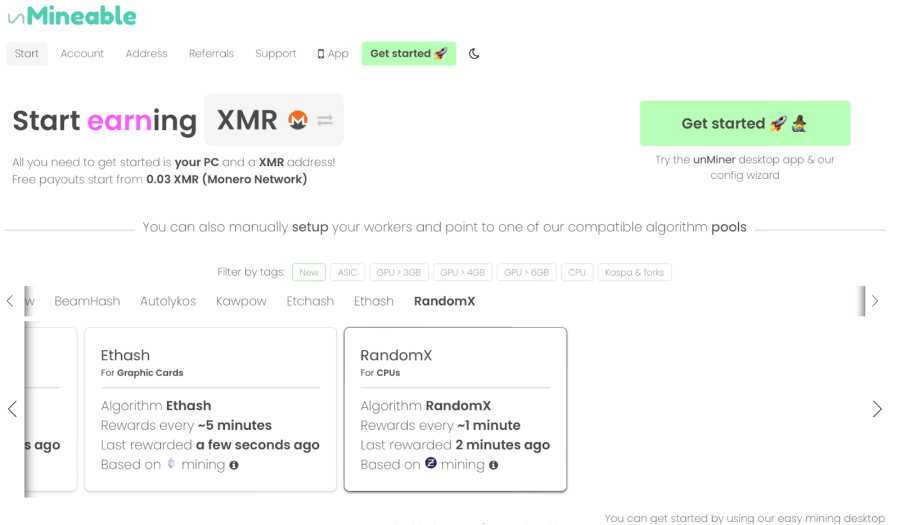
Source: Unmineable.com
- When you click on that, you’ll get redirected to a page with the link to Github. Click on it and choose xmrig-6.21.2-macos-arm64.targz for M1 Macs and the file below it for Intel-based Macs.
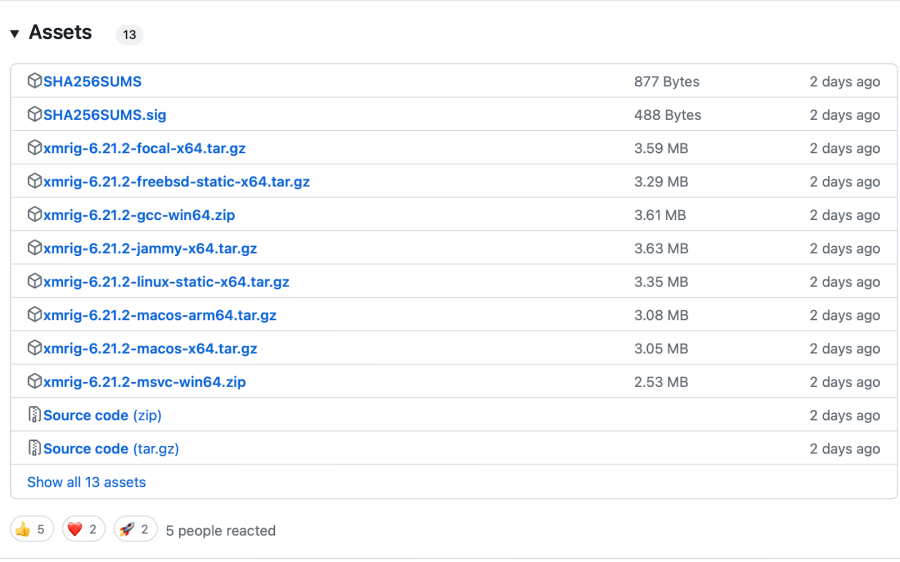
Source: GitHub.com
- Unpack the file. In the config.json you will need to make a few changes. Replace ‘null’ under ‘algo’ with “rx/0”, ‘coin’ with “Monero” and ‘url’ with the url of the global server from the Unmineable website, in this case, “rx.unmineable.com”. Next, under ‘user’ put in the symbol of the coin (in this case, XMR), followed by : and your wallet address, followed by a full stop and a user name (pick any name of your choice). Make sure to leave the speech marks in. Save the file.
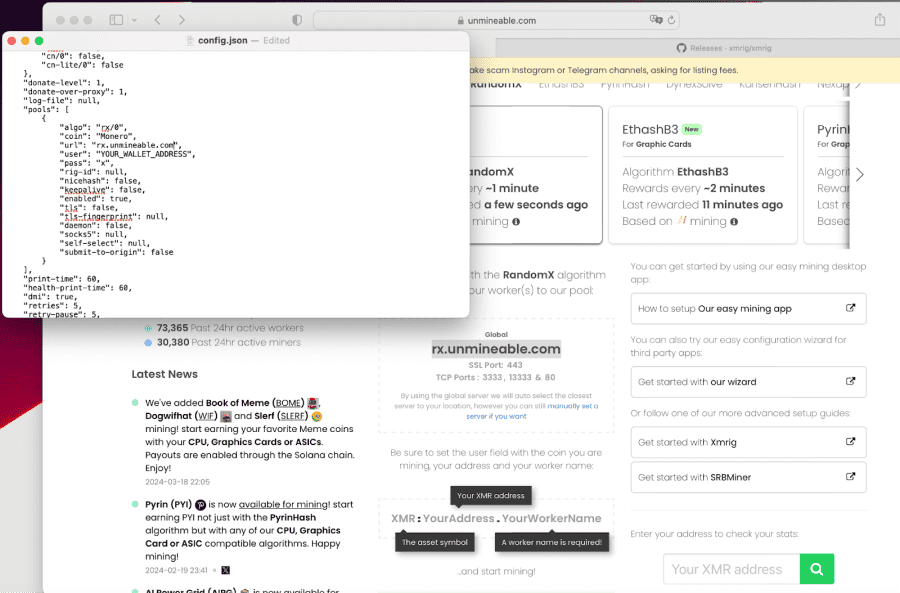
Source: xmrig, Unmineable.com
- Go to the Monero miner (xmrig) and start it. Voila! You are now mining Monero. To see how long it would take you to mine 1 Monero, go to unmineablesbest.com, choose your algorithm and enter your hash rate and sort by Time to payout. There is a long list of options that will let you see how long it would take you to get a payout and if it’s profitable to mine Monero for you.
Optimizing Mining Performance: Risks and Considerations
One of the key factors in any mining is the profitability of the process. Miners often set up in places that have the cheapest electricity, and with inflation and the increased cost of living across the board in 2024, cheap electricity is something you can’t get in most countries. The choice of mining equipment is also important. The more efficient the equipment, the more hash power you can benefit from with less energy consumption. The higher the hash rate, the better, as that will provide more power to solve those cryptographic puzzles faster.
Make sure to keep an eye on the growth of global Monero usage. There is no point in mining a dead token that has been long forgotten. Fortunately, Monero is a popular coin and can be a great asset to your portfolio.
One more thing worth mentioning is mining difficulty. Mining difficulty describes how challenging it will be to solve a block once it has been located. If the number of miners increases, the degree of
difficulty in mining will also grow. The average number of times a miner must compute a hash function in order to locate the block is displayed by the mining difficulty level. The hash rate is correlated with mining difficulty, which varies over time. The difficulty of mining rises with the number of miners; the difficulty decreases with the number of miners.
In addition, it’s wise to remember about market volatility. While you can mine a lot of Monero, the coin can drop in price, and you will lose your hard-earned crypto.
FAQ
How Long Does It Take to Mine 1 Block of Monero?
As with mining anything, this depends on your setup. To calculate how much Monero you’re going to be mining, you can use a Monero mining calculator.
Is It Legal to Mine Monero?
Monero is not an illegal cryptocurrency.
Is Monero Good for Mining?
It entirely depends on your setup. In some cases, it may not be profitable.
Can I Mine Monero at Home?
Yes, you can do that using CPU or even GPU.
Is Mining Monero Still Profitable?
It may not be. Take into account your hardware costs, electricity prices, mining difficulty, and the current Monero price to determine how profitable it is to mine Monero.
Is Monero Mining CPU or GPU?
Monero can be mined on both CPUs and GPUs, but the latter is much less efficient than the former.
How Much RAM Is Needed to Mine Monero?
A computer should have a powerful CPU and at least 2GB of RAM to mine.
How Much Monero Can I Mine in a Day?
To be honest, very little. It may be more financially rewarding to look for an instant crypto exchange, for instance, StealthEX, and buy the XMR crypto there.
StealthEX is here to help you buy Monero if you’re looking for a way to invest in this cryptocurrency. You can swap XMR privately and without the need to sign up for the service. StealthEX crypto collection has more than 2,000 different coins and you can do wallet-to-wallet transfers instantly and problem-free.
How to Convert Bitcoin to Monero?
Just go to StealthEX and follow these easy steps:
- Choose coins and amount you want to swap. For instance, BTC to XMR.
- Click the Start Exchange button.
- Provide the recipient XMR address to transfer your crypto to.
- Process the transaction.
- Get Monero into your wallet!
Follow us on Medium, X, Telegram, YouTube, and Publish0x to stay updated about the latest news on StealthEX and the rest of the crypto world.
Don’t forget to do your own research before buying any crypto. The views and opinions expressed in this article are solely those of the author.
BTC to XMR crypto mining Monero Monero XMR XMRRecent Articles on Cryptocurrency
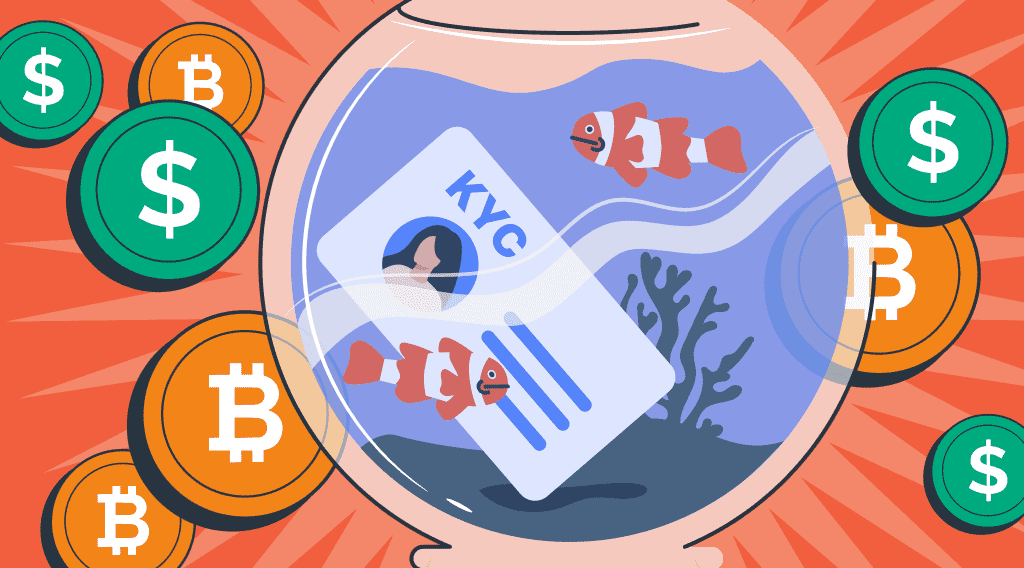 No KYC for Buying Cryptocurrency on StealthEX
No KYC for Buying Cryptocurrency on StealthEX 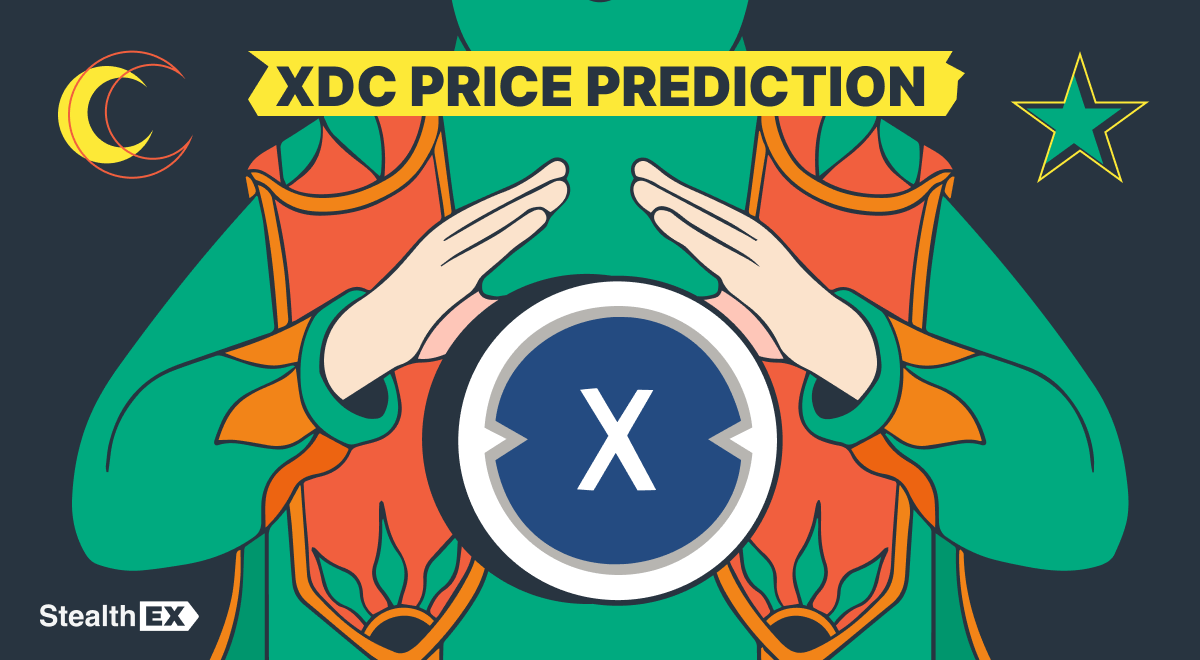 XDC Price Prediction: Will XDC Crypto Reach $10?
XDC Price Prediction: Will XDC Crypto Reach $10? 
